-
Countries
-
Data and Analysis
-
Special Focus
-
Crisis Responses
Return migration
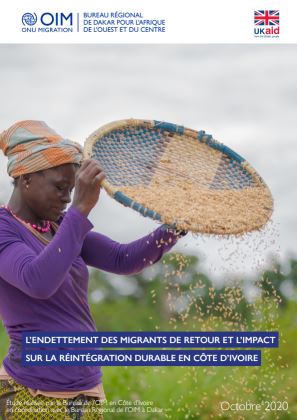
Contact
Aude Nanquette, Ananquette@iom.int
Language
French
Location
Côte d’Ivoire
Period Covered
Mar 19 2020
Apr 30 2020
Activity
- Other
- Survey
La présente étude s’intéresse à l’impact des crédits contractés par les migrants de retour sur leur réintégration en Côte d’Ivoire. Elle entend: 1) Détailler les montants, les mécanismes et les temporalités des différents types de prêts financiers effectués par les migrants, ainsi que les dimensions symboliques, psychosociales et culturelles de la dette. Il s’agira ainsi de comprendre l’influence éventuelle du crédit sur la décision de migrer, son rôle dans le financement du voyage, à quel moment du voyage il est contracté et enfin comment il peut affecter la réintégration du migrant à son retour en Côte d’Ivoire. 2) Avoir une meilleure compréhension des conditions de vulnérabilité consécutives aux prêts, et quels sont les différents acteurs de la dette. et 3) Informer les autorités nationales et internationales, ainsi que les différents acteurs partenaires sur les mécanismes et les impacts de la dette afin d’assurer une meilleure réintégration des migrants à la suite de l’abandon d’un projet migratoire. L'étude, effectuée du 19 mars au 30 avril 2020, se base sur les réponses fournies par 360 migrants de retour, âgés de 18 ans et plus, et qui ont été assistés dans leur retour en Côte d’Ivoire par l’OIM entre 2017 et 2020. Par ailleurs, des entretiens individuels ont été conduits auprès de huit sensibilisateurs communautaires. Cette étude est donc le résultat d’une approche de méthode de recherche mixte combinant des collectes de données quantitatives et qualitatives.

Contact
DTMAfghanistan@iom.int
Language
Pashto
Location
Afghanistan
Period Covered
Jan 01 2020
Jun 30 2020
Activity
- Mobility Tracking
- Baseline Assessment
د بېځایه کېدونکوو د تعقیب سیسټم په افغانستان کې د تحرک د ارزونې بنسټیزې وسیلې کاروي ترڅو له تحرکاتو څخه څارنه وشي او د نفوس په هکله اټکلونه، د جبري بېځایه کېدنو موقعیتونه او جغرافیه وي وېش څرګند شي. سربېره پر دې DTM د بېځایه کېدو مهال، علت، اصلی سیمې، لومړني جمعیتی معلومات، زیانمنتیاوې او د اړتیاوو د لومړیتوبونو څخه څارنه کوي. معلومات د کلیو په کچه کلیدي معلوماتو ورکوونکو سره د ډله ایز بحثونو او مخامخ کتنو له لارې راټولېږي.
د ۲۰۲۰ کال جون ۳۱ پر بنسټ په ۳۴ ولایاتو کې ۳۹۷ ولسوالی او ۱۲٬۳۳۵ کلي د ۶۲٬۱۹۴ کلیدي معلومات ورکوونکو سره د مرکې له لارې ارزول شوي دي. له ۲۰۱۲ کال څخه د ۲۰۲۰ کال جون میاشتې پورې ۳٬۸۸۱٬۹۰۳ راستنېدونکي و ۴٬۷۶۰٬۴۷۸ کورني بېځایه شوي چې اوسمهال په کوربه ټولنو کې اوسېږي پېژندل شوي دي.
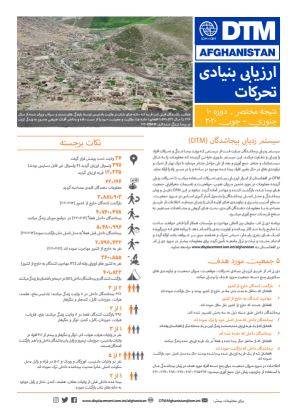
Contact
DTMAfghanistan@iom.int
Language
Dari
Location
Afghanistan
Period Covered
Jan 01 2020
Jun 30 2020
Activity
- Mobility Tracking
- Baseline Assessment
DTM در افغانستان از ابـزار ارزیـابی بنیـادی تحـرکات اسـتفاده میکنـد تا تحـرکات ردیابی گردیده معلومات در مورد تخمین مـیزان نفوس، موقعیـت و تقسیمات جغرافیایی جمعیت های بیجا شده اجباری، بازگشت کننده و مهاجر آماده گردد. علاوه بر این DTM دلایـل و زمان بیجاشدگی و محل اصـلی بیجاشدگان را بشمول آمار گیری اسـاسی در مـورد جمعیـت، سـطح آسـیب پذیـری و نیازمندی های اولیه آنان را ردیابی مینماید. اطلاعات از طریـق بحـث هـای گروهی اجتماعی بـا معلومـات دهنـدگان کلیـدی، و مشـاهدات مسـتقیم به سطح قریجات جمع آوری میشـود.
طبق ۳۰ جون سال ۲۰۲۰، ۳۴ ولایت، ۳۹۷ ولسوالی و ۱۲٬۳۳۵ قریه از طریق مصاحبه با ۶۲٬۱۹۴ معلومات دهندگان کلیدی ارزیابی گردیده اند. از سال ۲۰۱۲ الی جون ۲۰۲۰ به تعداد ۳٬۸۸۱٬۹۰۳ بازگشت کننده خارج از کشور و ۴٬۷۶۰٬۴۷۸ بیجاشده داخلی که در حال حاضر در جوامع میزبان زندگی میکنند شناسایی گردیده اند.
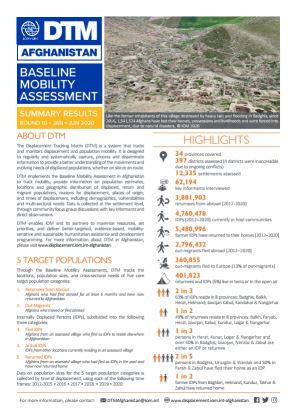
Contact
DTMAfghanistan@iom.int
Language
English
Location
Afghanistan
Period Covered
Jan 01 2020
Jun 30 2020
Activity
- Mobility Tracking
- Baseline Assessment
In Afghanistan, DTM employs the Baseline Mobility Assessment tool, designed to track mobility, determine the population sizes, locations and geographic distribution of forcibly displaced, return and migrant populations, reasons for displacement, places of origin, and times of displacement, as well as basic demographics, vulnerabilities and priority needs. Data is collected at the settlement level, through community focus group discussions with key informants and direct observations.
As of 30 June 2020, 34 provinces, 397 districts and 12,335 settlements have been assessed, including interviews with 62,194 key informants. Between 2012 and June 2020, 3,881,903 returnees and 4,760,478 IDPs currently living in host communities were identified.

Contact
DTM South Sudan, SouthSudanDTM@iom.int
Language
English
Location
South Sudan
Period Covered
Feb 01 2020
Mar 31 2020
Activity
- Mobility Tracking
- Baseline Assessment
Mobility tracking aims to quantify the presence and needs of internally displaced persons (IDPs), returnees and relocated individuals in displacement sites and host communities across South Sudan. The assessments are repeated at regular intervals to track mobility dynamics and needs over time. This summary presents the main findings on protection from the multi-sectoral location assessment component of the eight round of Mobility Tracking in South Sudan, carried out in February - March 2020. The report also includes spatial analysis of the proximity of IDP and returnee settlements to ACLED-recorded conflict events.

Contact
DTM South Sudan, SouthSudanDTM@iom.int
Language
English
Location
South Sudan
Period Covered
Feb 01 2020
Mar 31 2020
Activity
- Mobility Tracking
- Baseline Assessment
Mobility tracking aims to quantify the presence and needs of internally displaced persons (IDPs), returnees and relocated individuals in displacement sites and host communities across South Sudan. The assessments are repeated at regular intervals to track mobility dynamics and needs over time. This summary presents the main findings on shelter and non-food items from the multi-sectoral location assessment component of the eight round of Mobility Tracking in South Sudan, carried out in February - March 2020.
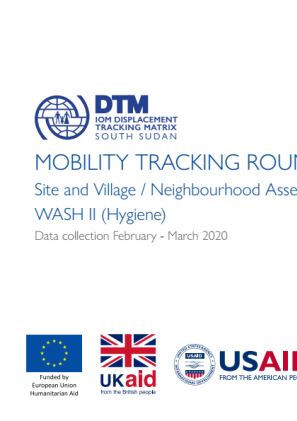
Contact
DTM South Sudan, SouthSudanDTM@iom.int
Language
English
Location
South Sudan
Period Covered
Feb 01 2020
Mar 31 2020
Activity
- Mobility Tracking
- Site Assessment
- Village Assessment
Mobility tracking aims to quantify the presence and needs of internally displaced persons (IDPs), returnees and relocated individuals in displacement sites and host communities across South Sudan. The assessments are repeated at regular intervals to track mobility dynamics and needs over time. This summary presents the main findings on WASH hygiene from the multi-sectoral location assessment component of the eight round of Mobility Tracking in South Sudan, carried out in February - March 2020.
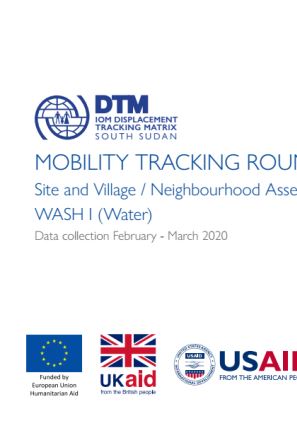
Contact
DTM South Sudan, SouthSudanDTM@iom.int
Language
English
Location
South Sudan
Period Covered
Feb 01 2020
Mar 31 2020
Activity
- Mobility Tracking
- Site Assessment
- Village Assessment
Mobility tracking aims to quantify the presence and needs of internally displaced persons (IDPs), returnees and relocated individuals in displacement sites and host communities across South Sudan. The assessments are repeated at regular intervals to track mobility dynamics and needs over time. This summary presents the main findings on WASH water access from the multi-sectoral location assessment component of the eight round of Mobility Tracking in South Sudan, carried out in February - March 2020.
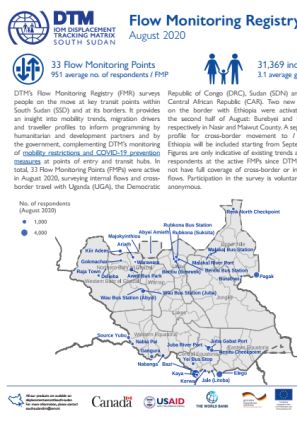
Contact
DTM South Sudan, SouthSudanDTM@iom.int
Language
English
Location
South Sudan
Period Covered
Aug 01 2020
Aug 31 2020
Activity
- Flow Monitoring
DTM’s Flow Monitoring Registry (FMR) surveys people on the move at key transit points within South Sudan (SSD) and at its borders. It provides an insight into mobility trends, migration drivers and traveller profiles to inform programming by humanitarian and development partners and by the government, complementing DTM’s monitoring of mobility restrictions and COVID-19 prevention measures at points of entry and transit hubs. In total, 33 Flow Monitoring Points (FMPs) were active in August 2020, surveying internal flows and crossborder travel with Uganda (UGA), the Democratic Republic of Congo (DRC), Sudan (SDN) and the Central African Republic (CAR). Two new FMPs on the border with Ethiopia were activated in the second half of August: Burebyei and Pagak, respectively in Nasir and Maiwut County. A separate profile for cross-border movement to / from Ethiopia will be included starting from September. Figures are only indicative of existing trends among respondents at the active FMPs since DTM does not have full coverage of cross-border or internal flows. Participation in the survey is voluntary and anonymous.
A disaggregated summary dataset for this report is available here.
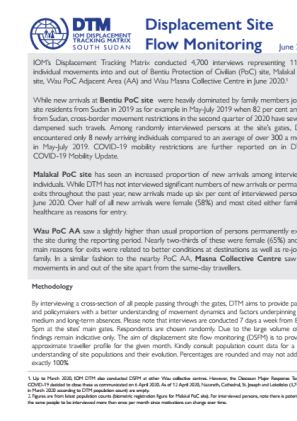
Contact
DTM South Sudan, SouthSudanDTM@iom.int
Language
English
Location
South Sudan
Period Covered
Jun 01 2020
Jun 30 2020
Activity
- Flow Monitoring
IOM’s Displacement Tracking Matrix conducted 4,700 interviews representing 11,661 individual movements into and out of Bentiu Protection of Civilian (PoC) site, Malakal PoC site, Wau PoC Adjacent Area (AA) and Wau Masna Collective Centre in June 2020.
While new arrivals at Bentiu PoC site were heavily dominated by family members joining site residents from Sudan in 2019 as for example in May-July 2019 when 82 per cent arrived from Sudan, cross-border movement restrictions in the second quarter of 2020 have severely dampened such travels. Among randomly interviewed persons at the site’s gates, DTM encountered only 8 newly arriving individuals compared to an average of over 300 a month in May-July 2019. COVID-19 mobility restrictions are further reported on in DTM’s COVID-19 Mobility Update.
Malakal PoC site has seen an increased proportion of new arrivals among interviewed individuals. While DTM has not interviewed significant numbers of new arrivals or permanent exits throughout the past year, new arrivals made up six per cent of interviewed persons in June 2020. Over half of all new arrivals were female (58%) and most cited either family or healthcare as reasons for entry.
Wau PoC AA saw a slightly higher than usual proportion of persons permanently exiting the site during the reporting period. Nearly two-thirds of these were female (65%) and the main reasons for exits were related to better conditions at destinations as well as re-joining family. In a similar fashion to the nearby PoC AA, Masna Collective Centre saw few movements in and out of the site apart from the same-day travellers.
Pagination
- Previous page
- Page 28
- Next page
